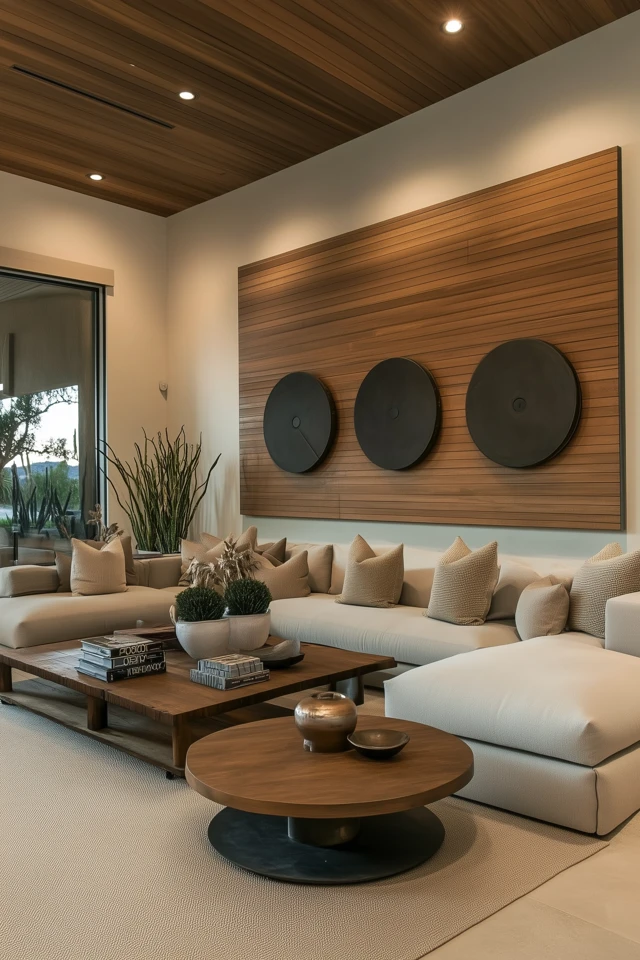Okay, confession time: I’m completely head-over-heels for the Japandi bedroom trend! It’s like my desire for a super calm, minimalist space finally met its cozy, comfy soulmate. If you’re dreaming of a bedroom that feels both peacefully zen and warmly inviting, you’ve got to explore this style. Let’s figure out how to bring that perfect blend of Japanese simplicity and Scandinavian comfort into your own sleep sanctuary!
17 Serene Japandi Bedroom Ideas for a Calm and Cozy Retreat
1. Embrace Serenity: The Essence of Japandi Bedroom Design

This room perfectly captures the Japandi spirit. Notice the blend of warm wood, cool concrete, clean lines, and soft lighting – key ingredients for that sought-after serene feel in your bedroom decor Japandi.
So, what’s the big deal about Japandi? At its heart, it’s this beautiful marriage between Japanese minimalism and Scandinavian ‘hygge’ (that wonderful feeling of coziness and contentment). Think clean lines, uncluttered spaces, and a deep respect for natural materials, borrowed from Japanese aesthetics. Then, layer in the warmth, comfort, and functionality that Scandi design is famous for. The result? A bedroom that feels incredibly peaceful, grounded, and just… right. It’s about creating a sanctuary, a calm retreat from the hustle and bustle of daily life, using intentional design choices.
Look closely at how this space balances different textures and tones. The smooth wood panels offer warmth, while the concrete wall adds a touch of modern coolness. The lighting is soft and ambient, crucial for creating that restful mood. It’s not about stark minimalism, but rather a mindful simplicity that feels both elegant and livable. This is the foundation upon which we’ll build more specific Japandi bedroom ideas!
2. Warm Woods & Bold Accents: A Modern Palette

See how the light wood bed pops against the dramatic dark wall? This modern Japandi look uses contrast effectively while maintaining serenity, thanks to the large windows connecting with nature. This is a great example of bedroom design Japandi.
While traditional Japandi palettes often lean heavily on soft neutrals, don’t be afraid to introduce some contrast! This gorgeous room demonstrates how a darker accent wall—like this rich, textured charcoal or deep stone—can create depth and sophistication without overwhelming the space. The key is balance. Here, the warmth of the light oak bed frame and flooring prevents the dark wall from feeling cold or imposing.
The expansive floor-to-ceiling windows are also doing some heavy lifting, flooding the room with natural light and blurring the lines between indoors and outdoors – another hallmark of Japandi style. Pairing these bolder choices with minimalist art and functional furniture, like that sleek leather armchair, keeps the overall aesthetic refined and uncluttered. It’s a perfect example of how Japandi style interior design can feel both contemporary and timelessly serene.
3. Cozy Textures Meet Nature: The Inviting Japandi Vibe

This space nails the cozy side of Japandi interiors bedroom. Soft white bedding, a warm throw, woven poufs, and the view of the lush garden create an incredibly inviting and peaceful atmosphere.
Okay, let’s talk cozy! While minimalism is key, a Japandi bedroom should never feel cold or sterile. This is where the Scandinavian influence really shines, bringing in layers of texture and warmth. Look how inviting this bed looks with its plush white duvet, subtly contrasted by that lovely terracotta-colored throw. Texture isn’t just visual; it’s tactile, making you want to snuggle in.
The woven poufs add another layer of natural texture and casual comfort, perfect for propping up your feet or setting down a book. And can we talk about that connection to nature? The bamboo plant inside and the stunning garden view outside work together beautifully. Wood paneling on the ceiling adds unexpected warmth overhead, completing this perfectly balanced, inviting Japandi inspired bedroom.
4. Texture Talk: Layering Linens and Natural Fabrics
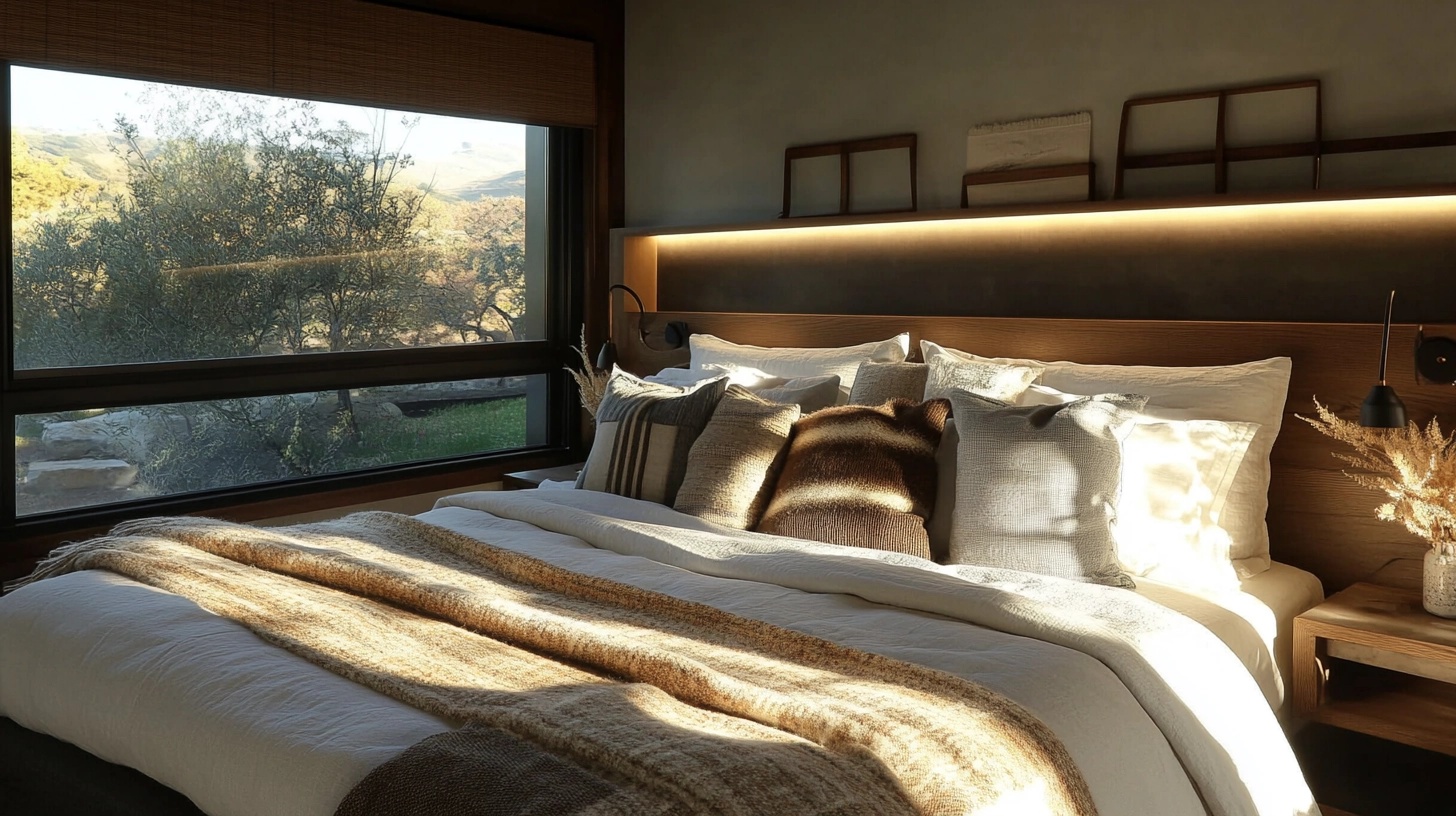
Get up close with Japandi comfort! Layering different textures like linen, knits, and maybe even a bit of faux fur adds depth and warmth without needing lots of color or clutter. These bedroom ideas Japandi style focus on touchable softness.
If there’s one secret weapon in the Japandi bedroom arsenal, it’s texture! When you’re working with a largely neutral color palette, varying the textures of your fabrics is crucial for adding visual interest and that all-important cozy factor. Think beyond basic cotton sheets (though good ones are always welcome!). Consider materials like slubby linen, chunky knits, soft wool, maybe even a touch of velvet or faux fur for pure indulgence.
Layering is your friend here. Start with your base bedding, then add a textured duvet cover, a folded knit throw at the foot of the bed, and an assortment of pillows in different fabrics and subtle patterns. See how the light hits the different weaves in this image? That interplay of light and shadow adds so much depth. Don’t be afraid to mix and match – the goal is a bed that looks (and feels) irresistibly comfortable and inviting, a key element of bedroom interior Japandi.
5. Embrace Imperfection: The Wabi-Sabi Touch

This room celebrates wabi-sabi – finding beauty in natural imperfections. The raw concrete, the rustic stump table, and the simple greenery create a grounded, authentic Japandi feel. It’s a core part of the Japandi bedroom aesthetic.
An essential concept borrowed from Japanese philosophy that fits perfectly within Japandi design is ‘wabi-sabi’. It’s all about finding beauty in imperfection, appreciating the natural cycle of growth and decay, and valuing authenticity. In a bedroom context, this means embracing materials that show their age or natural variations, rather than striving for flawless uniformity. Think raw, unpolished concrete walls, furniture made from reclaimed wood with visible grain or knots, handmade ceramics with slight irregularities, or even a beautifully weathered piece of decor.
This room captures that feeling so well. The slightly uneven texture of the concrete walls provides a stunning backdrop, full of character. The rustic wood stump table feels organic and grounded, a direct connection to nature. Even the placement of the plants feels natural and uncontrived. Incorporating wabi-sabi elements adds soul and personality to your Japandi bedroom, preventing it from feeling too sterile and reminding us to appreciate the beauty in the perfectly imperfect.
6. Connect with the Outdoors: Expansive Views & Natural Light

A key Japandi principle is connecting with nature. Huge windows like these flood the space with light and make the stunning landscape part of the room’s decor. This is Japandi interior design at its most breathtaking.
One of my absolute favorite aspects of Japandi design is its emphasis on bringing the outdoors in. It’s about creating a harmonious flow between your living space and the natural world. If you’re lucky enough to have large windows or a great view, make the most of it! Keep window treatments minimal – think sheer linen curtains or simple blinds that can be fully retracted – to maximize natural light and keep the view unobstructed.
Look how this room uses the incredible lake and mountain scenery as a living piece of art. The minimalist furniture, like the low bed and sleek chaise lounge, is arranged to appreciate the view. The light wood paneling complements the natural tones outside. Even if you don’t have a panoramic vista, placing a few well-chosen plants near a window or using natural materials can help forge that vital connection to nature, essential for a truly calming Japandi bedroom.
7. Light It Softly: Creating Calm Japandi Lighting

Lighting is crucial for Japandi calm. This room uses soft, warm overhead lighting recessed into the beams, complemented by the natural light from the huge windows. Layering light sources is key for Japandi style bedroom design.
Forget harsh, overhead glare! Japandi lighting is all about creating a soft, warm, and inviting atmosphere. Think layers of light rather than a single bright source. Ambient lighting, often diffused through paper lanterns (a nod to Japanese tradition) or recessed fixtures with warm bulbs, provides a gentle overall glow. Task lighting, like minimalist bedside lamps or subtle reading lights, offers focused illumination where needed. Accent lighting can highlight architectural features or artwork.
In this stunning example, the warm light integrated into the ceiling beams casts a beautiful, soft radiance across the room, enhancing the texture of the concrete walls and plush rug. During the day, the massive windows provide abundant natural light. Dimmer switches are your best friend in a Japandi bedroom, allowing you to adjust the mood from bright and airy to soft and restful as day turns to night. The goal is always tranquility and comfort.
8. Functional Beauty: Key Furniture for Japandi Interiors Bedroom

Japandi furniture combines clean lines with natural materials. This gorgeous floating platform bed with integrated lighting and a slatted headboard feels light yet grounded, perfectly embodying functional beauty. It’s a star piece for Japandi interiors bedroom.
When selecting furniture for your Japandi bedroom, focus on pieces that embody both simplicity and functionality. Clean lines, natural materials (especially wood like oak, ash, or walnut), and quality craftsmanship are paramount. Low-profile furniture, like the platform bed shown here, enhances the sense of space and calm, drawing inspiration from traditional Japanese living.
Look for pieces that serve a purpose without adding visual clutter. Think simple bedside tables, perhaps with a single drawer or shelf, a minimalist bench at the foot of the bed, or an elegant armchair for a reading nook. The “floating” design of this bed, enhanced by the subtle under-lighting, adds a touch of modern lightness while the warm wood keeps it grounded. Every piece should feel intentional and contribute to the overall serene aesthetic of your Japandi style interior.
9. Declutter with Purpose: Minimalist Japandi Storage Ideas
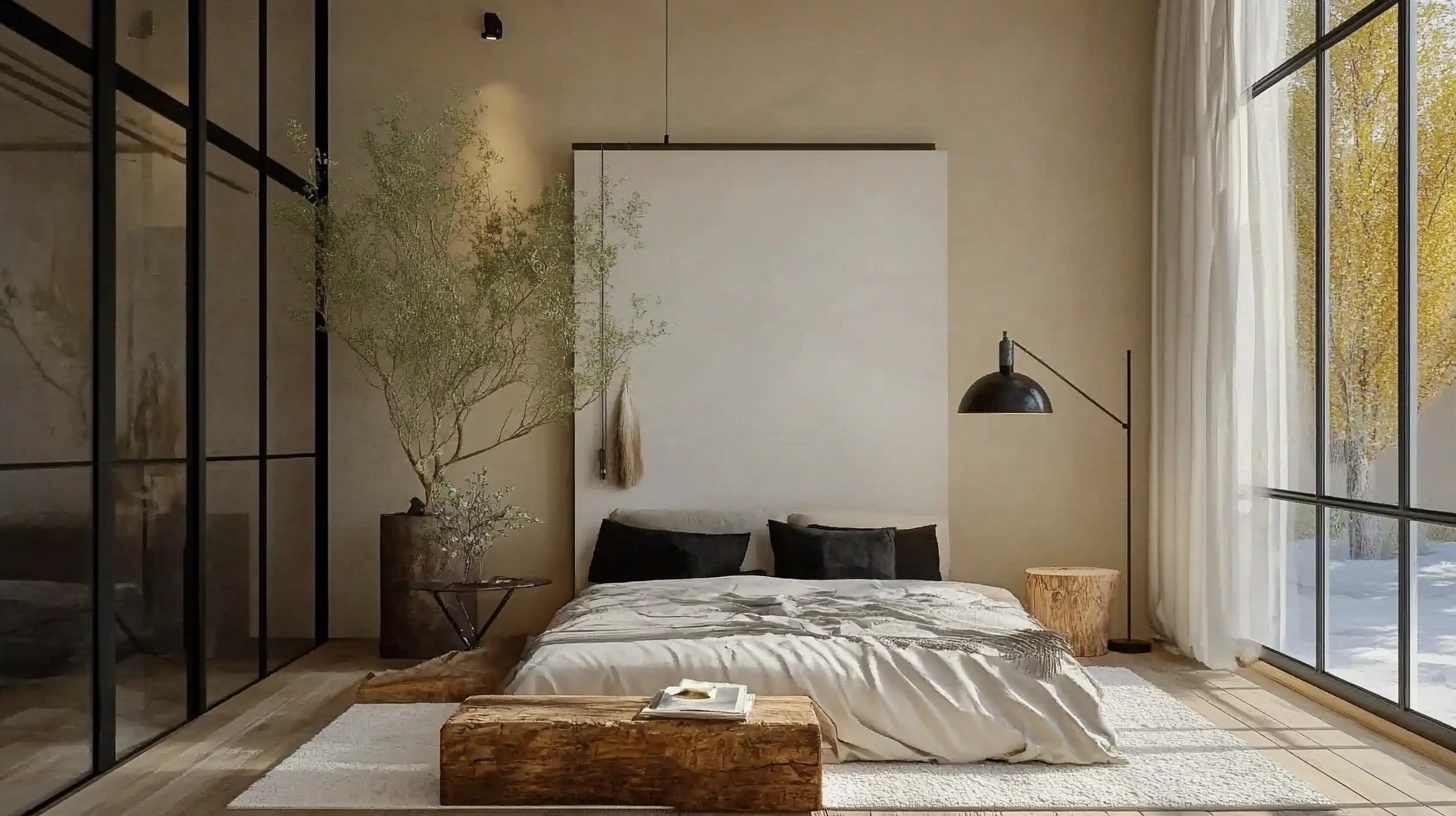
True Japandi isn’t just about less stuff, it’s about *intentional* stuff. While this image focuses on minimalism, practical storage is vital. Think built-ins, simple wooden benches (like the one here, which could hide baskets), or beds with drawers.
A cornerstone of both Japanese and Scandinavian design is the absence of clutter. A calm mind requires a calm space! This doesn’t mean you need to become an extreme minimalist overnight, but it does mean being intentional about what you keep in your bedroom and finding smart storage solutions for everything else. The goal is a visually clean and serene environment where everything has its place.
While this particular image emphasizes extreme minimalism with very few items visible, practical Japandi storage often involves integrated solutions. Think built-in wardrobes that blend seamlessly with the walls, platform beds with hidden drawers underneath (like the one in image #17!), simple wooden chests, or woven baskets tucked onto shelves or under benches. Choose storage pieces that align with the Japandi aesthetic – clean lines, natural materials, and functional design. Keeping surfaces clear is key to achieving that peaceful Japandi bedroom aesthetic.
10. Subtle Contrast: Adding Depth Without Clutter
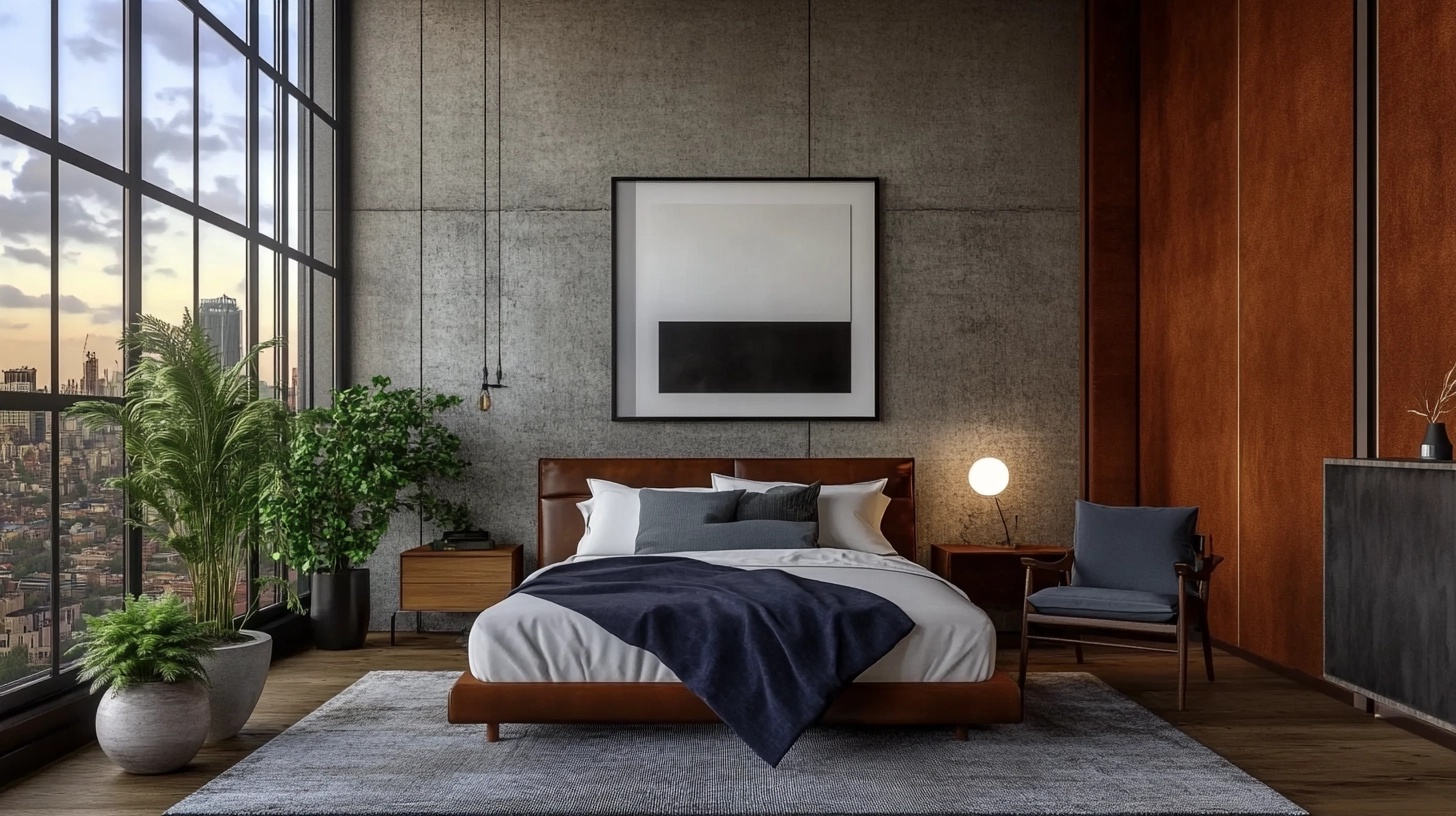
Contrast doesn’t have to be jarring. Here, the deep blue throw and chair provide a sophisticated counterpoint to the warm wood, leather bed, and concrete walls, adding visual interest without clutter. This adds depth to bedroom ideas Japandi.
While the core Japandi palette is neutral, adding subtle contrast is essential for preventing the space from feeling flat or monotonous. You don’t need bright, bold colors; instead, think about introducing slightly darker or richer tones through textiles, accent furniture, or artwork. This room does it beautifully – the deep, muted blue of the throw blanket and armchair stands out against the warmer wood tones and neutral concrete, creating focal points and adding a layer of sophistication.
Other ways to introduce subtle contrast include using black metal accents (like lamp bases or window frames, as seen in image #9), incorporating different wood tones (like pairing light oak with darker walnut accents), or choosing artwork with slightly deeper hues. The key is restraint. A few well-placed contrasting elements are far more effective in a Japandi bedroom interior design than overwhelming the space with too many competing colors.
11. Small Space, Big Zen: Japandi Style for Compact Rooms

Even darker palettes can work beautifully in Japandi design, creating a cozy, enveloping feel, especially effective perhaps in smaller spaces or rooms where you want extra snugness. The warm lighting prevents it feeling gloomy. This shows the versatility of Japandi style interior design.
Who says Japandi is only for large, airy spaces? You can absolutely bring that sense of calm and simplicity into a smaller bedroom. While lighter palettes are often recommended for small rooms to maximize the feeling of space, this example shows how a moodier approach can also be incredibly effective. The dark wood bed and matching nightstands create a cohesive, grounded look, while the large windows still connect the room to the outdoors, preventing it from feeling boxed in.
Key strategies for small Japandi bedrooms include using vertical space (think taller, narrow storage or wall-mounted shelves), choosing multi-functional furniture (like a storage bed), keeping clutter strictly under control, and utilizing mirrors strategically to reflect light and create an illusion of spaciousness. Floating nightstands can also free up floor space. Don’t shy away from Japandi just because your room is compact; its principles of simplicity and functionality are perfectly suited!
12. Rustic Meets Refined: Incorporating Raw Materials
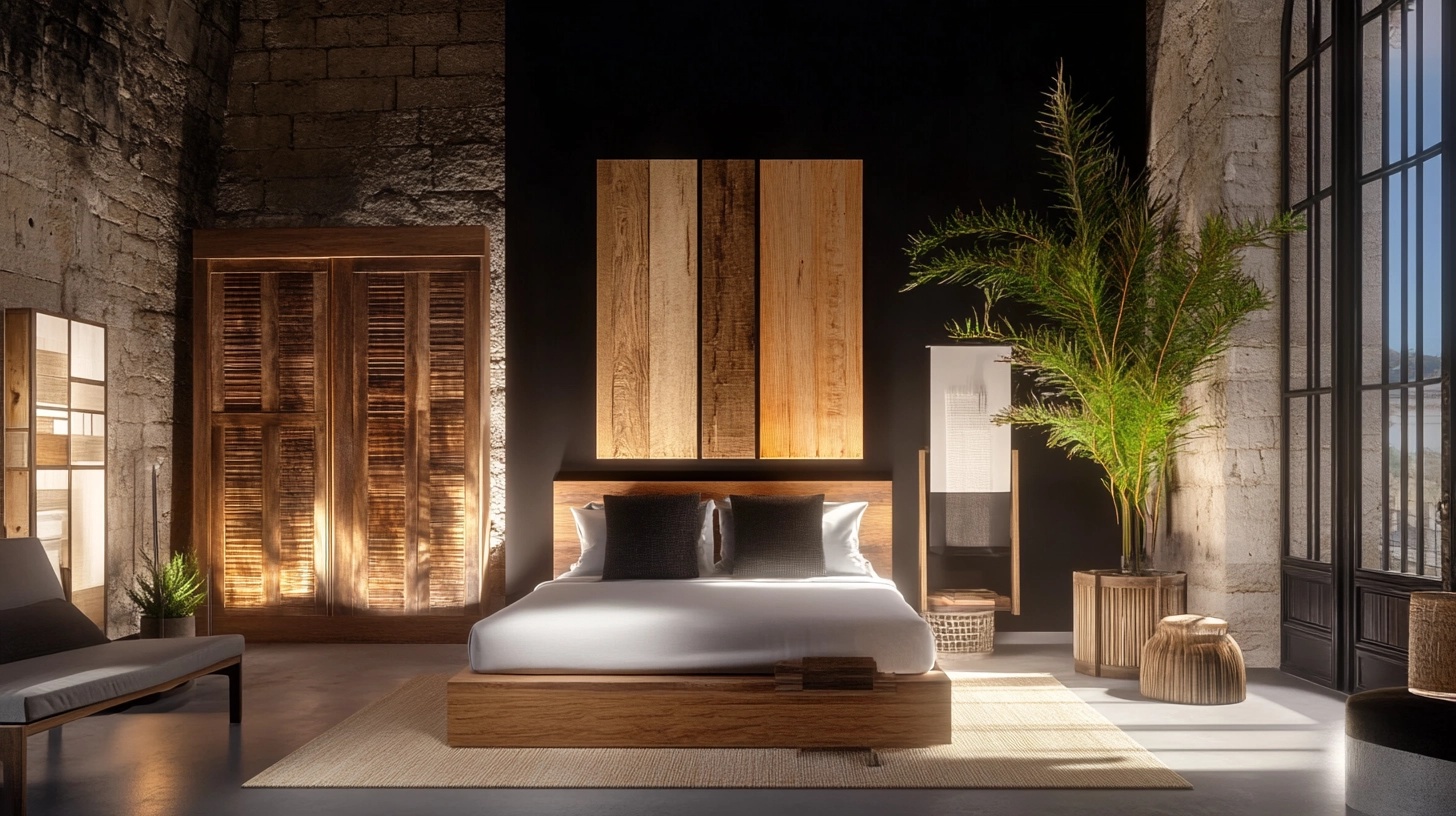
Japandi embraces natural materials in all their forms. Here, rough stone walls combine beautifully with warm wood shutters and a reclaimed wood headboard/art piece, adding immense texture and character. It’s a perfect example of Japandi inspired bedroom decor.
Let’s lean further into that wabi-sabi concept! Japandi design truly shines when it celebrates the raw beauty of natural materials. This room is a fantastic example, boldly featuring rough-hewn stone walls that add incredible texture and a sense of history. Instead of covering them up, they become a major design feature, perfectly complemented by the warmth of the wooden platform bed and tall window shutters.
The artwork above the bed, looking like reclaimed timber, reinforces this connection to natural, perhaps imperfect, materials. Even the simple addition of a large potted plant enhances the organic feel. If you have exposed brick, concrete, or stone in your space, consider making it a feature rather than hiding it. Pairing these rougher textures with softer elements like simple bedding and perhaps a smooth wooden floor creates that signature Japandi balance.
13. Curated Calm: Choosing Decor for a Japandi Bedroom Aesthetic
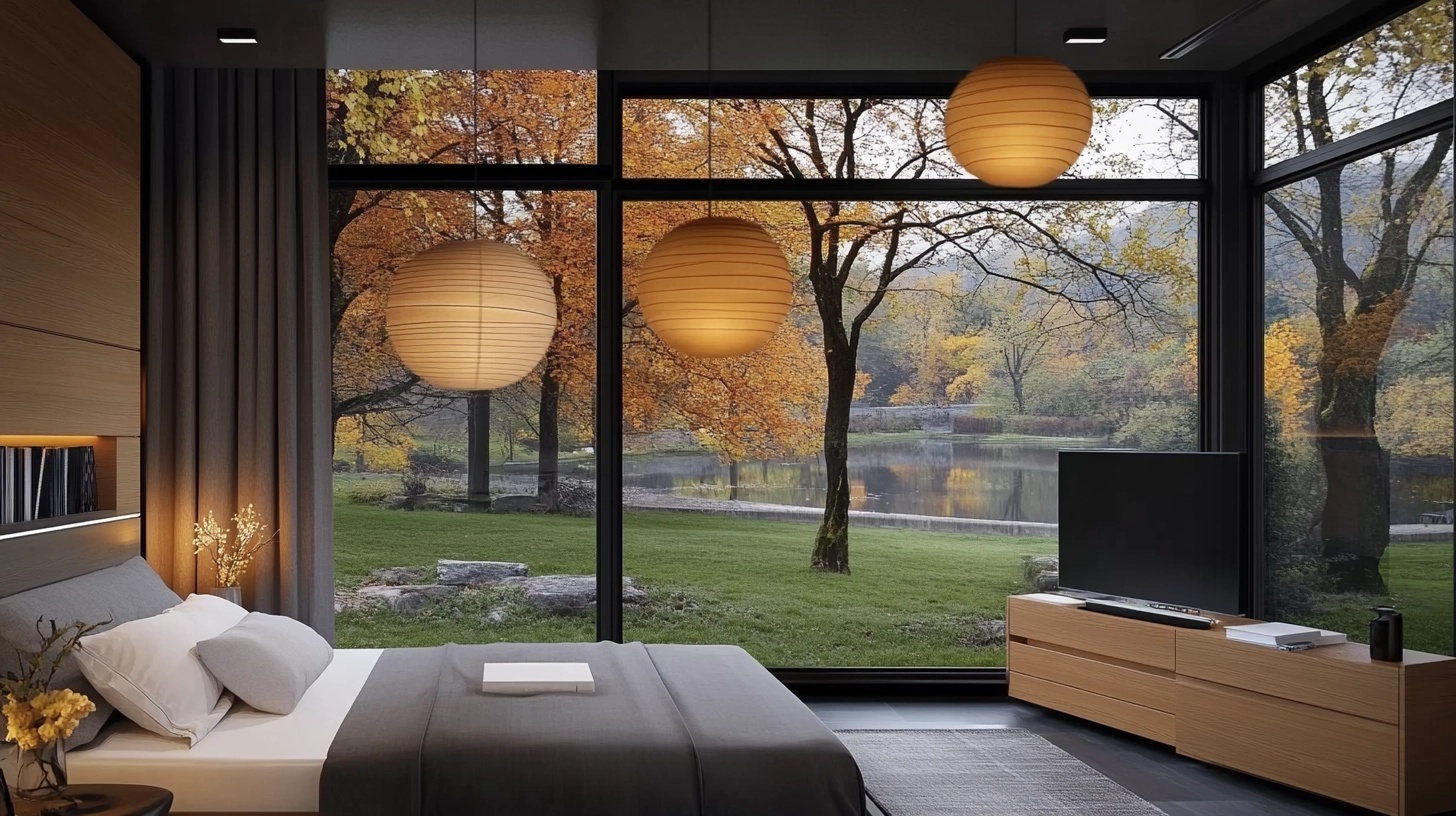
Simple, sculptural decor is key. These large paper lantern pendants are iconic choices for Japandi style, providing soft, diffused light and adding an artistic element without clutter. They perfectly suit the Japandi decor bedroom philosophy.
Decor in a Japandi bedroom follows the ‘less is more’ philosophy. Every item should feel intentional, functional, or bring a sense of calm and beauty. Avoid cluttering surfaces with knick-knacks. Instead, focus on a few carefully chosen pieces that enhance the serene atmosphere. Think simple ceramic vases (perhaps with a single stem or dried branch), minimalist artwork, a stack of books, or functional items elevated to art, like a beautiful tray or box.
Lighting fixtures themselves can serve as decor, as demonstrated by these gorgeous paper lanterns. They provide essential soft lighting while also acting as sculptural elements that draw the eye. The key is curation – selecting items that speak to you and contribute positively to the room’s overall feeling of peace and simplicity. Quality over quantity is the mantra for achieving the perfect Japandi bedroom aesthetic.
14. Bring Nature In: Plants and Organic Elements
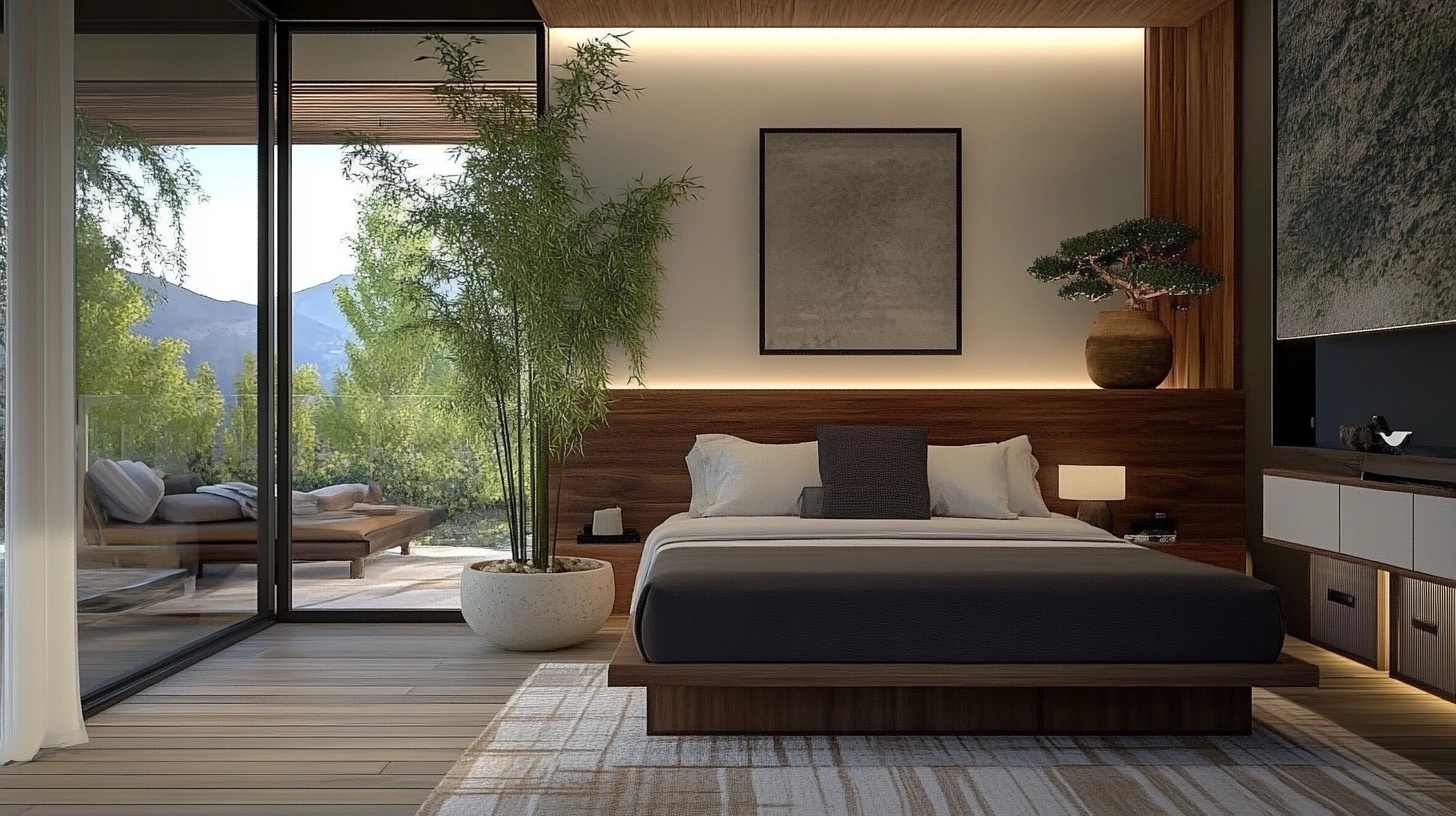
Plants are vital for bringing life and organic beauty into a Japandi space. A tall bamboo plant adds height and elegance, while a small bonsai brings a touch of traditional Japanese artistry. It’s essential for Japandi interiors.
We’ve touched on the connection to nature, but let’s specifically talk plants! Incorporating greenery is one of the easiest and most effective ways to enhance the Japandi feel in your bedroom. Plants purify the air, add a touch of vibrant life, and bring organic shapes that contrast beautifully with clean lines. Choose plants known for their simple, sculptural forms, like bamboo, bonsai trees, snake plants, or fiddle leaf figs.
Consider the pots, too – opt for simple ceramic, stone, or terracotta planters that align with the natural, neutral palette. Don’t overcrowd the space; often, one or two well-placed statement plants are more effective than lots of smaller ones. As seen here, a tall bamboo adds vertical interest, while the meticulously shaped bonsai on the nightstand adds an element of artistry and tradition. Plants are non-negotiable for an authentic Japandi interior bedroom!
15. Bedside Bliss: Simple and Stylish Nightstand Options
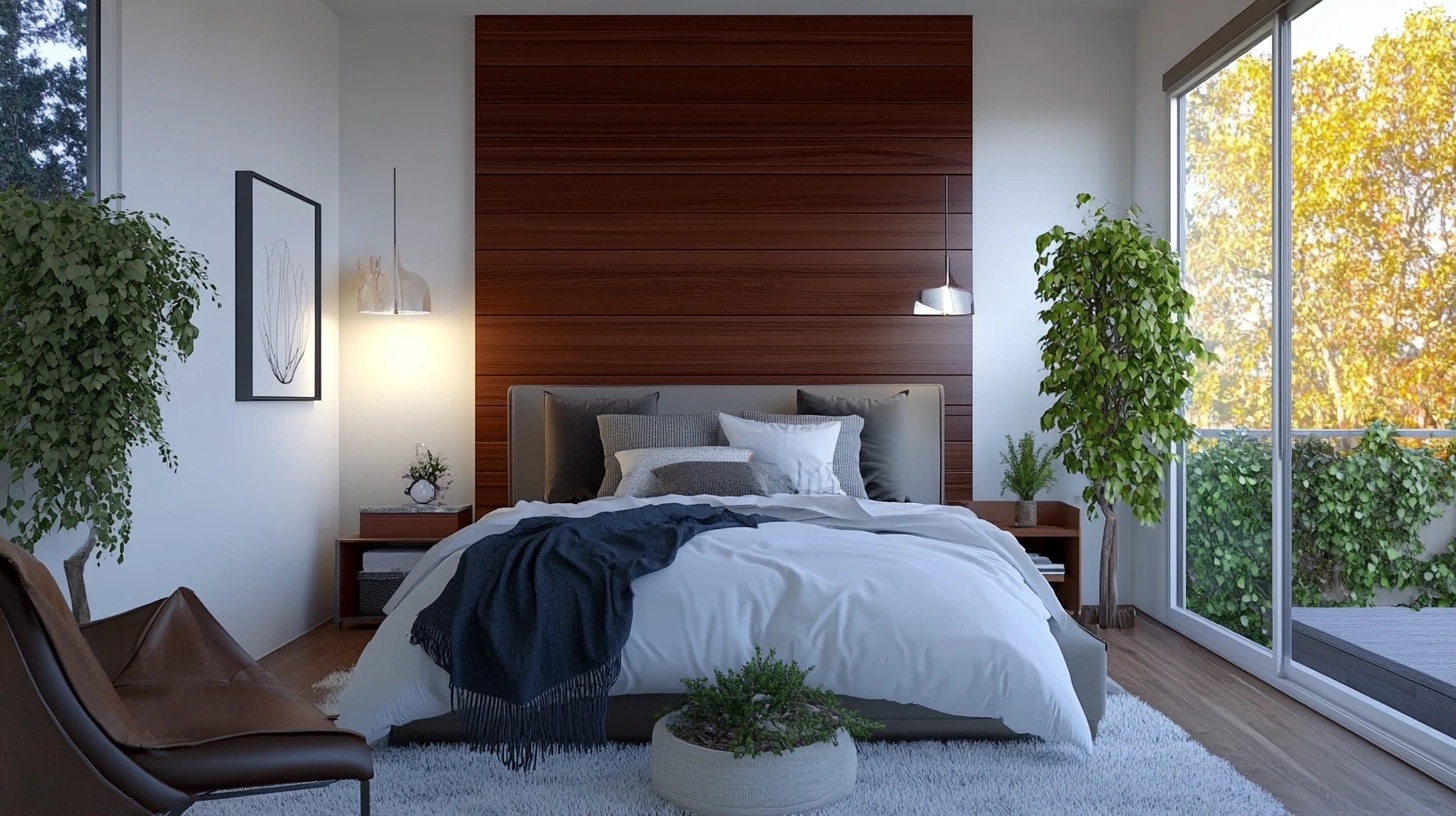
Japandi nightstands are typically clean-lined and functional. This dark wood example coordinates with the accent wall, offering simple storage without visual clutter, perfectly fitting the bedroom interior Japandi style.
Your nightstand is a small but crucial piece of furniture in the bedroom. In Japandi design, it should be functional, uncluttered, and aesthetically pleasing. Look for simple designs, often in wood that matches or complements your bed frame. Clean lines are key – avoid overly ornate details. Options range from simple floating shelves to minimalist tables with a single drawer or open shelf for essential items.
This room features matching dark wood nightstands that echo the accent wall, creating a cohesive look. They provide just enough surface space for a lamp, a book, and perhaps a small decorative item, plus some concealed storage. Remember the principle of keeping surfaces clear – try to store most items out of sight. A simple stool, a stack of books, or even a low bench can sometimes serve as unconventional yet stylish nightstands in a Japandi bedroom.
16. Japandi Bedroom Inspirations: Visualizing Your Space
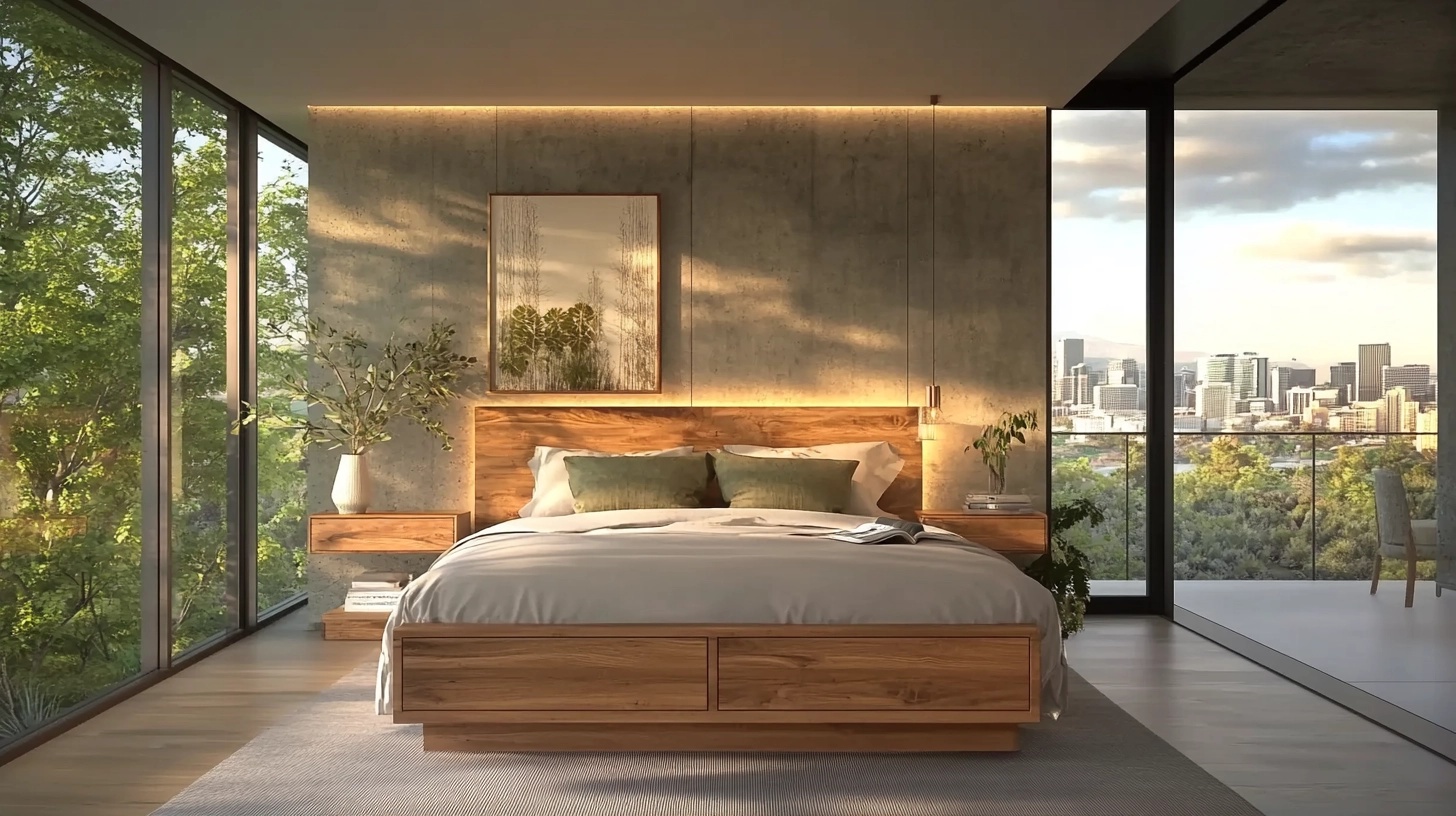
Draw inspiration from harmonious Japandi spaces like this one. Note the balance of light wood, cool concrete, greenery, simple art, and the integration of the outside view – even a city skyline can work! Use these as Japandi bedroom inspirations.
Sometimes, the best way to figure out your own style is to gather inspiration! Look at images like this one and identify the elements you’re drawn to. Is it the warmth of the light wood bed? The modern edge of the concrete wall? The way the plants soften the lines? Or how the stunning city view becomes part of the decor through those massive windows? Creating a Japandi mood board bedroom (either physical or digital on Pinterest!) can be incredibly helpful.
Collect images of textures, color palettes, furniture styles, and specific decor items that resonate with you. Notice the common threads – perhaps you consistently pin rooms with dark wood accents, or maybe you’re drawn to spaces flooded with natural light. This process helps clarify your vision and makes it easier to translate those Japandi bedroom inspirations into your own unique and calming retreat. Don’t just copy; adapt the ideas to your space and personality.
17. Achieve Ultimate Tranquility: Smart Storage Solutions

Ultimate tranquility requires organization! This bed cleverly incorporates storage with woven baskets, blending function and style seamlessly. Matching dressers keep the look cohesive. Smart storage is key for bedroom decor Japandi.
We circled back to storage because it truly is fundamental to achieving that lasting Japandi calm. A clutter-free space is a peaceful space. This final image showcases a brilliant example of integrated, stylish storage. The platform bed isn’t just a place to sleep; it features open cubbies perfectly sized for natural woven baskets, hiding away essentials while adding texture.
Coordinating this with a simple, low dresser in the same light wood finish creates a cohesive and functional storage system. Look for furniture pieces that work hard without shouting. Built-in wardrobes painted the same color as the walls can almost disappear, maximizing storage without visual weight. The goal is to ensure everything has a designated place, making it easy to tidy up and maintain that serene, uncluttered Japandi environment day after day. It’s the final touch for your ultimate tranquil retreat.
Frequently Asked Questions about Japandi Bedrooms
Q1: What exactly defines a Japandi bedroom style?
A: A Japandi bedroom beautifully marries Japanese minimalism (think simplicity, natural elements, tranquility) with Scandinavian hygge (coziness, functionality, comfort). The result is a space that feels uncluttered, serene, warm, and deeply restful, focusing on clean lines and natural materials.
Q2: What are the key elements needed for Japandi bedroom interior design?
A: Focus on natural materials like light or dark wood, bamboo, and rattan, paired with textured fabrics such as linen and wool. Keep decor minimal but intentional, emphasizing craftsmanship and functionality. Incorporate low-profile furniture, soft, diffused lighting, and perhaps a touch of nature with a simple plant.
Q3: What color palette is typical for Japandi bedroom ideas?
A: Japandi palettes are typically neutral and calming, using shades like oatmeal, beige, cream, stone grey, and soft white as a base. Contrast is often added through darker, muted tones like charcoal, dusty greens, or deep blues, often drawn from natural wood or stone elements, rather than bright, bold colors.





